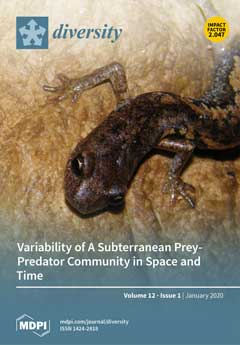Estuaries serve as important nursery habitats for various species of early-life stage fish, but can experience cooccurring acidification and hypoxia that can vary diurnally in intensity. This study examines the effects of acidification (pH 7.2–7.4) and hypoxia (dissolved oxygen (DO) ~ 2–4 mg
[...] Read more.
Estuaries serve as important nursery habitats for various species of early-life stage fish, but can experience cooccurring acidification and hypoxia that can vary diurnally in intensity. This study examines the effects of acidification (pH 7.2–7.4) and hypoxia (dissolved oxygen (DO) ~ 2–4 mg L
−1) as individual and combined stressors on four fitness metrics for three species of forage fish endemic to the U.S. East Coast:
Menidia menidia,
Menidia beryllina, and
Cyprinodon variegatus. Additionally, the impacts of various durations of exposure to these two stressors was also assessed to explore the sensitivity threshold for larval fishes under environmentally-representative conditions.
C. variegatus was resistant to chronic low pH, while
M. menidia and
M. beryllina experienced significantly reduced survival and hatch time, respectively. Exposure to hypoxia resulted in reduced hatch success of both
Menidia species, as well as diminished survival of
M. beryllina larvae. Diurnal exposure to low pH and low DO for 4 or 8 h did not alter survival of
M. beryllina, although 8 or 12 h of daily exposure through the 10 days posthatch significantly depressed larval size. In contrast,
M. menidia experienced significant declines in survival for all intervals of diel cycling hypoxia and acidification (4–12 h). Exposure to 12-h diurnal hypoxia generally elicited negative effects equal to, or of greater severity, than chronic exposure to low DO at the same levels despite significantly higher mean DO exposure concentrations. This evidences a substantial biological cost to adapting to changing DO levels, and implicates diurnal cycling of DO as a significant threat to fish larvae in estuaries. Larval responses to hypoxia, and to a lesser extent acidification, in this study on both continuous and diurnal timescales indicate that estuarine conditions throughout the spawning and postspawn periods could adversely affect stocks of these fish, with diverse implications for the remainder of the food web.
Full article





